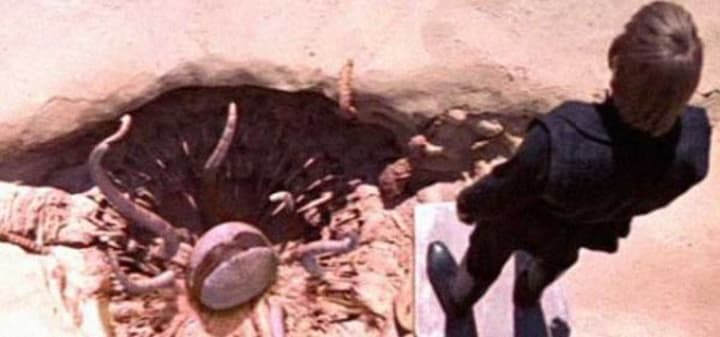Facts About The Sarlacc You Didn't Know
There's More To This Creature Than Meets The Eye!

The Star Wars universe is packed with strange creatures and monsters. It’s because of things like this that it appears interesting and diverse. Over the years we have gotten to know these creatures and monsters and learn more about them through various layers of media. One creature/monster that we don’t know too much about however, is the sarlacc. The sarlacc was first introduced to the Star Wars universe in the 1983 movie Return Of The Jedi.
C-3PO: "You will therefore be taken to the Dune Sea and cast into the Pit of Carkoon, the nesting place of the all-powerful sarlacc."
Han Solo: "Doesn't sound so bad."
C-3PO: "In its belly, you will find a new definition of pain and suffering, as you are slowly digested over a thousand years."
Chewbacca: "Aaarrrr!"
Han Solo: "On second thought, let's pass on that, huh?"
―C-3PO, translating for Jabba the Hutt, delivers a death sentence to Luke Skywalker, Han Solo, and Chewbacca.
RELATED: The Top 10 Weidest Things In 'Star Wars'
At the time we were never given anything more than those lines in the film and the visuals of the sarlacc in the Pit of Carkoon. But what do we know about sarlaccs these days?
Sarlaccs don’t always live in holes in the ground
Until they reach adulthood, sarlaccs roam around and hunt their prey like most carnivorous, tentacled creatures. This no surprise as sarlaccs are related to rathtars with a large maw, tentacles and a voracious appetite. Both the rathtar and sarlacc adapted differently to become great hunters in their specific environments, with the sarlacc becoming the largest and least mobile of its relatives.

Sarlaccs have a terrifying anatomy
Just like cows on earth, the sarlacc has more than one stomach. This is pretty logical given that they are going to be digesting food for over a thousand years. Throw in the tentacles and the many rows of teeth and we end up with something most unpleasant, given that the teeth would make it impossible for any victim to climb out once they had entered the sarlacc’s mouth!
Sarlaccs don’t become an adult until they are 30,000
Given that a victim would take one thousand years to digest in the stomach of a sarlacc, it it perhaps unsurprising that they don’t become adults until their 30,000th birthday.
Sarlaccs are very tall
Sarlaccs start their lives as spores, but grow with age. Once sarlaccs reach maturity, they burrow themselves nearly 100 meters below the surface, feeding on creatures and humanoids unfortunate enough to fall into their mouths.
Sarlaccs torture its victims physically and mentally
Victims of the sarlacc were injected with immobilizing neurotoxins with the purpose of extracting nutrients from them and keeping them alive far beyond their normal life spans. The neurotoxins caused constant pain and, while still conscious, the prey was digested for a thousand years, due to the creature's weak stomach acid. We've now seen the damage a sarlacc can do in The Mandalorian and The Book Of Boba Fett.

The sarlacc used to look more sinister
Over the years there has been much debate about the rights and wrongs of George Lucas tinkering with his Star Wars movies. One of the things I always struggled with was the changes that he made to the sarlacc in Return Of The Jedi. I always felt that the teeth and tentacle look of the sarlacc made it seem like a really menacing and sinister monster. Once George had revisited the look and tweaked it, we ended up with a ‘monster’ that looked really cute and resembling Audrey II out of Little Shop Of Horrors. Well that was my take on it anyway!


READ NEXT: Star Wars Theory: What If The Emperor Won In 'Return Of The Jedi'?
Written by KT Glitz
Source(s): CBR, Wookiepedia
Syndicated from Culture Slate






Comments
There are no comments for this story
Be the first to respond and start the conversation.